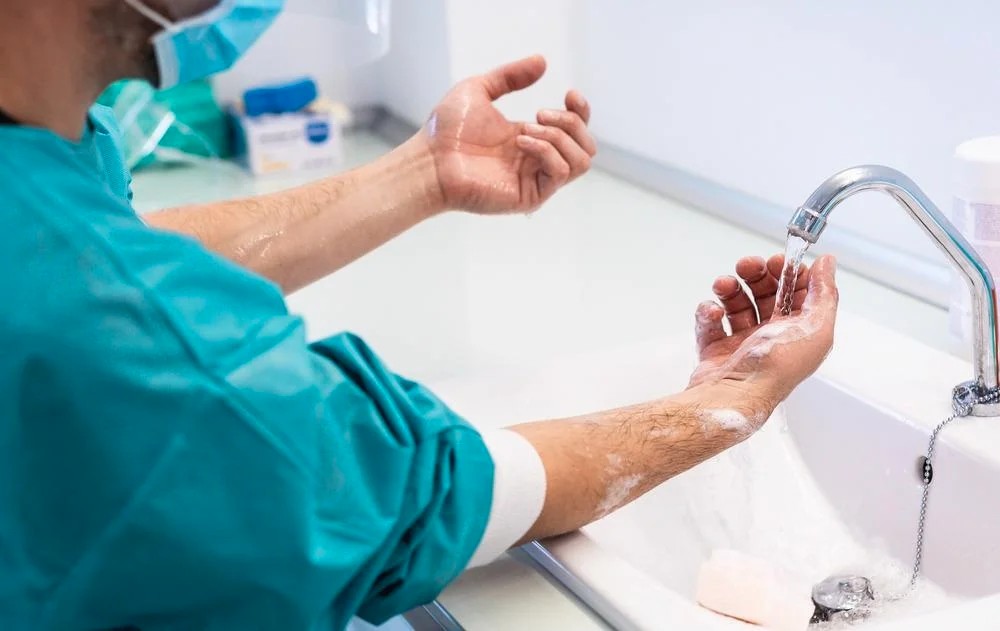
Preventing the spread of infection is essential in healthcare settings to ensure the safety and well-being of patients, staff, and visitors. Hand washing is one of the most effective ways to prevent infection transmission in healthcare settings. It helps to eliminate pathogens that can be spread from one person to another. By practicing good hand hygiene, healthcare workers can reduce the chance of spreading infections such as bacteria, viruses, and other harmful microorganisms. Hand washing is an essential and simple practice that can save lives and stop the spread of disease.
There are two types of hand hygiene in healthcare settings: antiseptic and routine. Both are essential for preventing the spread of infections. To maintain proper hand hygiene protocols, healthcare workers must be familiar with both types.
- Routine Hand Hygiene: This is the practice of washing your hands with soap and water to get rid of dirt, debris, and any other microorganisms. This is a good method to prevent the spread of infection in healthcare settings. After handling medical equipment or devices, before and after contact with patients, and after using the bathroom, healthcare workers should practice routine hand hygiene.
- Antiseptic Hand Hygiene – Antiseptic hand hygiene uses alcohol-based hand sanitizers and antiseptic rubs to kill skin microorganisms. This is a great option when soap or water are not readily available or when caring for patients with highly infectious diseases. Healthcare workers must use antiseptic hand hygiene before and after patient contact, before performing invasive procedures, and after touching contaminated surfaces.
While antiseptic hand hygiene can reduce the number of microorganisms on the skin, it cannot remove dirt, blood, or other organic matter. Therefore, routine hand hygiene should be your first choice if your hands are visibly dirty. To prevent the spread of infection, healthcare workers must follow proper hand hygiene protocols. This includes the recommended duration, amount of soap or sanitizer, and hand washing techniques.
Let us know about the Hand wash steps in hospital:
- Wet hands: Start by wetting your hands with clean, running water.
- Use soap: Apply soap to your hands and lather well.
- Scrub Your Hands: Scrub your hands for at least 20 seconds. Make sure you cover all surfaces of your hands, including your fingertips, thumbs, and wrists.
- Rinse Your Hands: Rinse your hands under clean, running water.
- Dry Your Hands: Use a towel or an air dryer to dry your hands.
- Hand Sanitizer: If you are unable to wash your hands with soap and water, use an alcohol-based hand sanitizer that contains at least 60{6103ad273ea573951f45aeae1bb7c2101189d3473d5b9a48ab81f8440d2357b8} alcohol. Use enough to cover all surfaces of your hands, and rub your hands together until they are dry.
Let us now read about the Hand washing steps for nurses:
- Take out Jewelry: Remove all jewelry, including watches and rings, before washing your hands.
- Wet hands: Wet your hands with clean, running water.
- Use soap: Apply soap to your hands and lather well.
- Scrub Your Hands: Scrub your hands for at least 20 seconds, making sure to cover all surfaces of your hands, including your fingertips, thumbs, and wrists.
- Clean under Nails: Use a nail cleaner to clean under your nails.
- Rinse Hands: Rinse your hands thoroughly under clean, running water.
- Dry Your Hands: Use a towel or an air dryer to dry your hands.
- Use Hand Sanitizer: If you are unable to wash your hands with soap and water, use an alcohol-based hand sanitizer that contains at least 60{6103ad273ea573951f45aeae1bb7c2101189d3473d5b9a48ab81f8440d2357b8} alcohol. Apply enough sanitizer to cover all surfaces of your hands and rub your hands together until they are dry.
Consequences of poor hand hygiene in healthcare settings
Poor hand hygiene can lead to serious consequences in healthcare settings, such as the spread of infections, higher healthcare costs, and harm to patients. Here are some of the consequences of poor hand hygiene in healthcare settings.
- Infections: Poor hand hygiene is one of the leading causes of healthcare-associated infections (HAIs), which are infections that patients acquire while receiving medical treatment in a healthcare facility. HAIs can be caused either by bacteria, viruses, or fungi. They can be especially dangerous for patients with weak immune systems or undergoing invasive procedures.
- Higher Healthcare Costs: HAIs can lead to high healthcare costs both in terms of direct medical costs and indirect costs like lost productivity and disability. The Centers for Disease Control and Prevention estimates that the cost of HAIs in the United States ranges from $28 billion to $45 billion annually.
- Patient Harm: Poor hand hygiene can lead to patient harm, such as long hospital stays, disability, and even death. Patients who get infections while in the hospital are more likely to experience complications, require additional treatments, and have longer hospital stays than those who do not.
- Staff illness: Healthcare workers who don’t practice good hand hygiene can also be at risk of contracting infections from patients. This can result in absenteeism, reduced productivity, and even illness-related disability.
Poor hand hygiene can lead to serious consequences in healthcare settings. This highlights the importance of following proper hand hygiene protocols to prevent the spread of infections and protect patients, healthcare workers, and visitors.
Compliance with hand hygiene
Compliance with hand hygiene protocols is a key component in preventing the spread of infections in healthcare settings. Studies have shown that healthcare workers often fail to comply with proper hand hygiene protocols, increasing the risk of infection transmission. Ensuring effective infection prevention and control requires understanding the challenges associated with compliance, and implementing strategies to improve it is essential.
One of the primary challenges associated with compliance with hand hygiene protocols is the complex healthcare environment. Healthcare workers often face a heavy workload, limited time, and competing priorities that can make it challenging to follow proper hand hygiene protocols. A lack of access to hygiene resources such as soap, water, or alcohol-based hand sanitizers can also result in low compliance rates.
Healthcare facilities can implement various strategies to address these issues and improve compliance with hand hygiene protocols. These strategies may include:
- Education and Training: Healthcare workers can be educated and trained on proper hand hygiene techniques, and the importance of compliance can improve awareness and promote adherence to protocols.
- Monitoring and Feedback: Regularly monitoring compliance rates and providing feedback to healthcare workers can help to identify areas that need improvement and promote accountability.
- Access to Hand Hygiene Resources: Compliance can be encouraged by making sure that resources such as soap, water, and alcohol-based hand sanitizers are easily accessible and readily available.
- Leadership Support: A culture of safety and leadership support can help to promote compliance with hand hygiene protocols. This can be done by emphasizing the importance of infection prevention and control.
In conclusion, compliance with hand hygiene protocols is crucial in healthcare settings to prevent the spread of infections. Healthcare facilities can tackle the issues associated with compliance through education, training, monitoring, feedback, access to hand hygiene resources, and leadership support.
To ensure the safety of patients, staff, nurses, and visitors, healthcare professionals must follow specific hand-washing protocols in their work environment. By following these hand-washing steps, you can help to prevent the spread of infections and create a healthy and safe environment for everyone.








